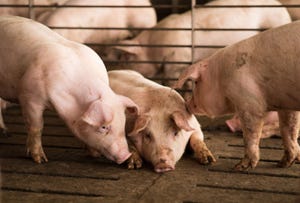Pigs: A host for a vast array of viruses
U.S. swine herd has not been implicated in the highly pathogenic avian influenza transmission to date.
April 11, 2024
.jpg?width=850&auto=webp&quality=95&format=jpg&disable=upscale)
By Tom Molitor, College of Veterinary Medicine, University of Minnesota
The swine industry has changed significantly since 1980 with intensified swine systems, early weaning approaches, three site production systems, AI, (both artificial intelligence and artificial insemination), facility filtration systems and overall enhanced biosecurity. Throughout this time we have witnessed consistent and recurring emerging and reemerging diseases that have impacted the health of swine and affected profitability.
The major culprits in such emerging diseases in swine have been viruses. Both new and old viruses have served as constant threats to the U.S. swine industry. Eradication of selected diseases such as pseudorabies have been beneficial, yet new viral diseases have emerged. Globalization has impacted the introduction and spread of new diseases such as porcine epidemic diarrhea in 2013 to the United States and the threat of African swine fever to the United States today.
Allen D. Leman recruited me in 1979 to work on a new USDA funded project on infectious causes of swine reproductive failure. He and others were using the term "SMEDI" to characterize the manifestations of reproductive failure such as stillbirths, mummification and embryonic death. Han Soo Joo and Bill Mengeling in landmark studies separately showed a few years earlier that porcine parvovirus was not just a contaminant from cell culture but a virus that could cause SMEDI. At the time PPV was an emerging disease agent along with enteroviruses and pseudorabies virus.
Working for Leman and his graduate student, the unforgettable Ross Cutler, provided a start on a most enjoyable journey of research and teaching on swine virology. There has been much virus fodder to work with during this past 45 years. Viruses prominent along the journey include PPV, pseudorabies, encephalomyocarditis, of course porcine reproductive and respiratory syndrome virus, porcine circovirus, porcine respiratory coronavirus, transmissible gastroenteritis virus, PEDV, rotaviruses, foot and mouth disease virus and ASFV to name a few. In addition, there are specific viruses such as porcine cytomegalovirus, porcine endogenous retrovirus and hepatitis E viruses, not necessarily important as disease causing agents, yet critically important when pig cells and tissues are used in Xenotransplantation.
Typically, there are very few entering veterinary students that have an interest in pigs. In an attempt to justify talking about pigs in a veterinary virology class, I started a class with the statement that pigs are virus factories. The rationale was that if the library of virus agents that infect pigs were viewed and emphasized it would enhance the interest of students, at least justify why it was necessary to talk so much about pigs.
Viruses that infect pigs represent almost every family of animal viruses. Many swine viruses do indeed cause disease, many do not. The Reoviridae family of viruses which include rotaviruses, are named after respiratory and enteric orphan viruses. Orphans because they do not all cause disease. We do know that several rotaviruses do cause disease in pigs–check any veterinary diagnostic laboratory that handles pigs. The approach taken to the students on virus factories, while truthful, did not necessarily convince the majority of students. An exception to such disinterest was a veterinary student at the time, Matt Allerson, recently named the 2024 AASV Practitioner of the year.
Pigs are indeed virus factories. A factory that produces a unique and varied product not an assembly line that is producing massive quantities of the same product. There may be a new model, a new strain or variant each year, not the same production line. The most obvious constantly emerging and reemerging virus is influenza where pigs are known to facilitate the creation of novel reassortant influenza A virus strains, capable of causing pandemics.
The 2009 pandemic influenza (H1N1) was referred to as swine flu. This influenza pandemic sparked examination of viral transmission between people, pigs and other species. The Center for Disease Control concluded the H1N1 Influenza was first seen in humans and was likely then transmitted to swine populations. One of the first documented cases of influenza in pigs in this pandemic was at the Minnesota State Fair, transmission from children to show pigs. The genetic makeup of the 2009 pandemic flu was the reason for the swine flu reference, not direct evidence of transmission. Nonetheless, pigs got a bad rap in 2009 as the origin of the pandemic. The CDC states that humans can be infected by swine flu strains, but it is not common.
Most recently in 2024, the bird flu H5N1 was shown in Texas to infect cattle and from cattle to a human. This is highly unusual to have an avian bird flu H5N1 strain infect humans and especially through cattle. Pigs have not been implicated in the bird flu transmission in the U.S. to date. There have been H5N1 bird flu viruses recovered from swine in Indonesia (Chairul et al 2010).
In addition to influenza as a potential zoonotic viral agent pigs play a role in the amplification of Japanese encephalitis virus, transmitted by mosquito vectors found in areas inhabited by over half the world's human population (McLean and Graham 2022). Pigs notably acted as an amplifying host in the most severe outbreak of Nipah virus in Malaysia, an outbreak that necessitated culling of over 1 million pigs. Finally, novel porcine coronaviruses are being discovered in high pig-density countries which have pandemic potential. COVID-19 has increased the awareness and concern of mutating coronaviruses. We will not discuss coronaviruses in pigs here but in a future issue.
Pigs serve as a host for a vast array of viruses. Pigs can serve as a reservoir an amplifying hosts and indeed pigs can serve as a virus factory.
References:
Chairul A. Nidom, Ryo Takano,et al 2010..Influenza A (H5N1) Viruses from Pigs, Indonesia. Emerg Infect Dis. 16: 1515–1523.
McLean R. and Graham S. 2022. The pig as an amplifying host for new and emerging zoonotic viruses. One Health 14.
You May Also Like



